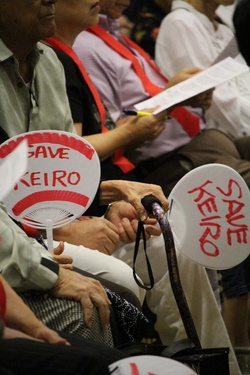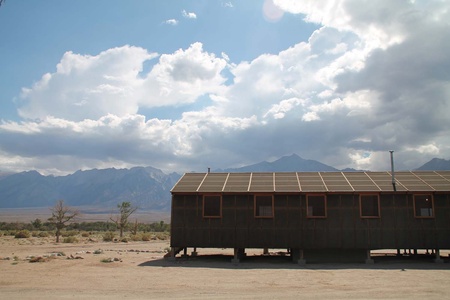Grandparents are speaking English! I was shocked when I came here from Japan about a year ago. I had never seen elderly people speak English in Japan (maybe because I was in the countryside). Even young people have a hard time, so I couldn't believe that people who look just like my grandmother could speak English fluently. I didn't know anything about "Japanese people".
What sparked my interest in Japanese Americans was a visit to the Japanese American National Museum. After seeing the Hello Kitty exhibit, which I was looking forward to, I was casually browsing the permanent exhibition introducing the history of Japanese Americans. As I was reading the explanation in Japanese, an elderly volunteer called me over and asked, "Shall I explain it to you in Japanese?" Then, about an hour long, one-on-one VIP tour began. Although I had studied history seriously in Japan, I learned a lot of things for the first time, including life in the internment camps and the existence of the 442nd Regiment. Standing in front of a model of the Manzanar internment camp, I felt strange and wondered, "Did something like this really happen?"
"You can get there by car from here," I was told, so in August 2015, I headed to Manzanar on business. I wanted to feature it in a special issue of the Japanese-American magazine where I work, marking the 70th anniversary of the end of the war. It was about a five-hour drive from Los Angeles. In an area with nothing but mountains, rocks, and sand, there was a gymnasium-like museum, a hut that recreated what it was like at the time, and a watchtower. When I got out of the car, the hot air blew up dust and my skin burned. "Can people really live in a place like this?"
When I asked the receptionist, he asked curiously, "How did you know about this place?" There are many Japanese visitors to California, but few who visit Manzanar. To begin with, the existence of "Japanese Americans" and "internment camps" is rarely discussed in Japan.

One month after learning about the history of Japanese Americans at Manzanar, I met some modern Japanese Americans. An elderly woman sent me an email requesting an "urgent interview." The content of the email was about the sale of the Japanese elderly care facility "Keiro." At the time, I had only been in Los Angeles from Japan for six months, and I didn't even know that there was a Japanese elderly care facility. There was sushi, ramen, and a temple, but did they even have an elderly care facility? What surprised me the most was that the explanation of the sale of the elderly care facility, and the rally against it, were mainly conducted in "English." I learned for the first time that even though they are all called Japanese Americans, the language they speak, the environment they grew up in, and their way of thinking are all different, from first generation to second, third, and fourth generation.
Learning about the history of Japanese Americans who left Japan and built lives in America will be useful for Japanese people living in the present day. In the midst of unstoppable globalization, there is much to be learned from this reliable guidepost. I am looking forward to finding new guideposts by learning about the history of Japanese Americans.
© 2016 Yumi Mizukoshi




